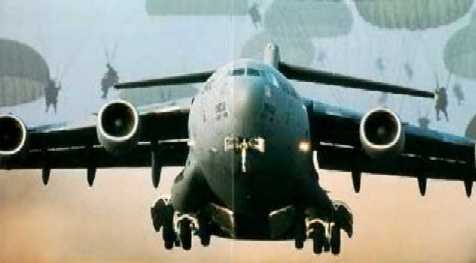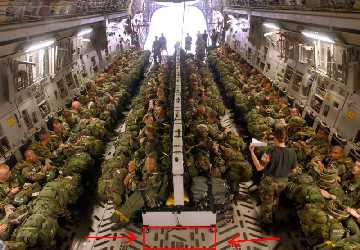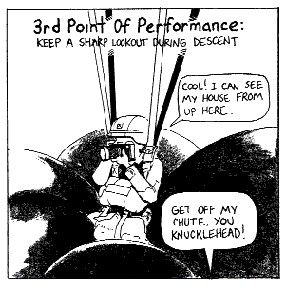

Here is how it went.
One of the 1st TSG (A)'s free-thinkers ponders why the wide-body C-17 can only carry 102 Paratroopers but the less powerful but longer C-141B its replacing can carry 153. He discovers from the Boeing brochure that 6 more seats can be fitted to carry 6 more Paratroopers. Everybody likes the idea except, guess who?
The following highlights how often our own officer corps is our own worst enemy. You can follow below the idea evolution, and you'll see a good daily case of how a few guys who care are slowly grinding their teeth flat. We've pasted below some excerpts of some research an officer has been doing to get additional seats in the forward centerline portion of the C-17, and raise it's passenger load from 102 to 108 Paratroops. This officer did an enormous amount of work, studying specs, contacting Boeing, the USAF, and many others. Did the USAF fight him? No. Did Boeing fight him? No. Guess who did?

Initial author's e-mail:
Sir,
Reading the 2002 C-17 Technical Description and Planning Guide on page 5-16 it describes how a ninth 6-seat module can be fitted to the normal 48 centerline seats. This would give use 108 Paratroopers per C-17 chalk instead of 102. I thought this was extraordinary so I called Boeing to be sure.
Mr. Jim Lis
Boeing Aircraft Company Airlift & Transport
2401 E. Wardlow Rd
Long Beach, Ca 90807-5309
(562) 496-9686
james.lis@boeing.com
He reports that the Aerial Port Squadrons should have extra 6 seat modules that could be asked to provide the needed extra capacity.
Author's Follow-up:
Sir,
discussing the ninth 6-seat centerline module option which would take up the space for a comfort pallet, Mr. Lis noted that the aircrew lavatory is the same one used in a MD-80 passenger jet and could easily accommodate the #2 bathroom needs of everyone on the C-17 while the two troop doors have urinals with modesty screens to handle the #1 needs of everyone on board. There are also drinking water coolers onboard.
It seems reasonable that we do not need the comfort pallet and could better use that space for 6 hard-charging fighting Paratroopers of combat power.
Boeing's feedback:
"To all: One key issue that would still need to be addressed is the duration of the flight. Although the commercial style lavatory is up front and there are two urinals in the back. Flight duration coupled with a full load of 108 jumpers versus 102 would need to be, at the least, considered from a biological standpoint. This is no showstopper, especially in combat. Additionally, an analysis of the Personnel airdrop system (anchor cables, retriever winches, etc..) would also need to be accomplished since the C-17 is certified for 102 jumpers at 400# each. Also, attached is a picture of the seats and configuration, which should help some. Sorry for the slow response. Jim"

Author's Reply:
"Gentlemen,
Thanks, Jim for the graphic!
The excellent graphic Mr. Lis shared with us states that 48 centerline seats are stored for potential use in a C-17 (8 modules of 6 seats). Since a 9th module for 54 centerline seats can be fitted, why not make this module standard carry on the C-17?
We are all creatures of habit, if we see 48 seats strapped to the C-17 cargo door we will assume only 48 more extra seats are available, if we have 54 seats then we'll know that 54 seating is available.
The current stowage provisions are located in the mid center section of the cargo door. The space is precisely sized to accommodate the 8 sets of seats that are part of the basic configuration requirements. Adding another section would require additional space somewhere. We store so much stuff on the aircraft now, there is very little free space readily available. There are also some contractual issues which would need to be addressed such as weight, provisioning, configuration management etc. These are all workable but need buy-in from AMC and the SPO to make happen. If a spare set of seats are carried today, they are usually restrained to the floor which generally tends to take up space for cargo. This is just the high level stuff. The important thing here is addressing the technical issues surrounding the additional 6 jumpers (102-108).
1st TSG Staff's comment:
All this discussion in itself is motivating. It means people are thinking.
I think we need to mention that while those extra seats might not become the norm as far as installation (although the airborne would prefer that), if they are carried and accessible, they could be mounted without a huge logistical challenge. If the DRB or DRB (-) ever must fly strategically, the USAF may be packing lighter versus when they come up to Pope for LPW.
While we are in a war on terrorism, if we had to exercise the forced entry operation, I'm sure all sorts of restrictions would disappear, and finding seating space would become high visibility priority.
Stop the presses!
"Please not the technical issues with adding an additional 6 jumpers. This does not take into account for additional testing that would have to be accomplished. Finally, there would also have to be a requirement for an additional 6 jumpers on the C-17. The current requirement is 102."
Thanks,
Very Respectfully,
XXXXXXXXXXXXXXXXXX
Major, U.S. Army
Director, Army C-17 Requirements Office
ASC/YCR
Wright-Patterson AFB, OH 45433
Duty Phone: DSN: XXX-XXXX or Commercial (XXX) XXX-XXXX
Fax - DSN: XXX-XXXX or Commercial (XXX) XXX-XXXX
Our conclusion:
Aside from the cryptic, broken English, does this mean that the Army won't load 108 because one of its Majors doesn't want to?
That is about the most pathetic narrow minded thinking we've seen in years. "Please not[e] the technical issues"? Please don't burden him with questions or interest?
It's too damn difficult to get the USAF and the Airborne and Special Operations Test Board to test strength on four anchor line cables? Even though that would cost money, how much did we spend alone developing the C-17? This closed door thinking which regards questions and innovation as threatening to one's existence highlights a whole other issue when we talk about mediocrity in thought. With guys like this around the Sherman tanks would never have busted out of the Normandy hedgerows, because a bocage-lifting hull weren't part of a requirement. The C-47 never would have been an aerial fire support platform because it was never a requirement. How about that idea to stretch the C-141A into the -B configuration? I'm sure a requirements officer too fought that one. Oh yes, when the CH-47 was in it's infancy, clearly in 1960s there was a man saying: "I think we ought to explore in-flight refueling, terrain following radar, and FLIR."
The Army officer Corps...our own worst enemy!
Why 108 Paratroopers instead of just 102 is vital to America's Army
That's essentially another C-17 per 20 chalks. Since the DRB (+) (w/IRC) requirement is 220+ C-17 sorties, and at best we'll ever have is 180 x C-17s, every airframe counts.
If you really think about it: if the dual rail is working well, with LVAD we realy get our bang for our buck with the C-17. It can fly 7,000 miles, refuel in flight, etc.
We only get comfort out of the C-17 in terms of Paratroop drops. 132 guys out of a C141B that can fly tight intervals, or a C-17 that puts out only 100 (2 safeties don't jump but pull in static lines) and puts out a huge spiralling vortice that requires larger formation intervals.
The C130J-30 Hercules stretched fuselage model (CC-130J) flies far, could be bought with an in-flight refuelling receptacle, and can drop 90!
Max number of jumpers per anchor cable:
Inboard anchor line cable: 24
Outboard: 27
Rangers enroute to Just Cause pissed in 5-gallon jerrycans.
Six more seats per C-17 should be created ASAP. What really goes in that empty space: the USAF puts all their duffel bags there and ratchet them down. There are other places they could do this: strap bags to a wall in netting, secure them to the ramp, etc. God forbid the Air Force travel light: extra flight suit, 1 set civilian clothes, PT clothes and shave kit. Anything more is another fraudulent TDY claim.
We're not sure you'd want to add any more Paratroops: the wide aisles greatly aid in-flight rigging, safety, and even rest. At combat speed, it would still take you at least 50 seconds to exit 100-106 guys. (Safeties get seats, but don't jump obviously). Additionally the USAF will never give up a flight deck rest area seat to a safety. Still adding six seats means a reduction of .7 C-17s sorties per Bn TF. It all adds up in the long run.
The Airborne must live up to its full potential to provide three dimensional maneuver to the modern battlefield; if we are to get bad guys fleeing across borders and take-down dictatorships with the disadvantage of time and long distances we need to GET EVERY POSSIBLE PARATROOPER TO THE GROUND per aircraft for mamimum combat power. If the spec was written for just 102 jumpers that's because the people writing the spec did not know that 108 jumpers could deploy from a C-17.
Now we know.
We still do not have even close to the number of C-17s we need to fully execute all our missions and every 6 Paratroopers we can add per C-17 translates into battle-winning force on the ground. We must train on the 108 jumpers per C-17 as standard operating procedure now during peacetime so itll be automatic capability during war time. So if it takes obtaining more seats, then lets get more seats.
[EDITOR: this extra seating is good only for airland operations because there isn't enough space to jump.]
www.afmc.wpafb.af.mil/HQ-AFMC/PA/news/archive/2003/Mar/0332-03.htm
C-17 adds seating capacity
AFMC News Service Release 0332
Released Mar. 20, 2003
By Capt. Krista Carlos
437th Airlift Wing Public Affairs
CHARLESTON AIR FORCE BASE, S.C. (AFMCNS) - C-17 Systems Program Office experts gave the new C-17 palletized seating system a "thumbs up" during a recent egress test, potentially enabling the aircraft to increase its troop-transport capability from 102 to 189.
SPO officials at Wright-Patterson Air Force Base, Ohio,, Boeing representatives and flight test engineers from Edwards Air Force Base, Calif., successfully egress-tested the seating system Feb. 19 at Pope Air Force Base, N.C. In that test, 188 passengers and eight aircrew members evacuated the aircraft in less than 50 seconds, said 2nd Lt. Dave Bartley, C-17 mission systems program manager at Wright-Patterson.
"You can expect to see the seats become operational soon," said Bartley. "The seats have successfully completed the egress portion of the test, but still must undergo the final approval by the engineering department before they can be deemed 'airworthy.'"
With the C-17's seating capacity only half that of the C-141, Air Mobility Command's combat mission needs statement outlined a void in the command's ability to transport combat troops into and out of austere combat airfields during contingency operations.
"This (palletized seating) is not a new concept," said John O'Sullivan, Boeing quality assurance manager. "It was used in the C-141 and it adds capability to the C-17 that it currently doesn't have."
Each seat pallet can be configured to hold 10 or 15 seats, said O'Sullivan. The egress test at Pope tested two configurations. One configuration used nine seat pallets, no comfort pallet and 188 passengers. The other configuration was eight seat pallets, comfort pallet and 163 passengers.
The goal was to evacuate all passengers in less than 90 seconds, the Federal Aviation Administration standard.
The test used the worst-case scenario first, using the right-hand troop door and one emergency exit for both configurations, said O'Sullivan. Test experts expected some obstacles, but the passengers were able to successfully evacuate in less than 50 seconds for both seat set-ups, eliminating a need to continue with any more egress testing.
Along with the increased capability, the seats should also provide a more comfortable trip on C-17s for AMC passengers, said Maj. John Pepin, 437th Aerial Port Squadron operations officer here.
"Flying a 10-12 hour mission can take a toll on passengers, so the new seats will be a useful asset," said Pepin.
Charleston and McChord Air Force Base, Wash., will receive 17 sets of palletized seats each, said Bartley. Ten sets have arrived at Charleston. The remaining seven sets should arrive before mid-March.
"It's a very valuable capability to help transport more troops to different locations and will potentially decrease the workload of the aircraft," said Bartley.
Questions or comments? Please Contact
HQ Air Force Materiel Command
4375 Chidlaw Road, Bldg. 262, Room N-152 Wright-Patterson AFB, Ohio 45433
(937) 257-7603 or DSN 787-7603
email: webmaster@wpafb.af.mil
Last modified: 11-May-04
FEEDBACK!
E-mail 1st TSG (A) itsg@hotmail.com
